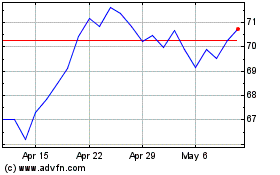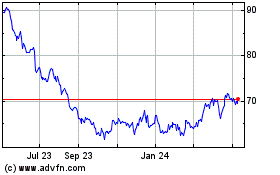By Leslie Josephs
Investors are starting to lose their appetite for food
stocks.
Last week's strong jobs report bolstered the case for a December
interest-rate rise in the U.S., prompting investors to move money
out of companies that have offered steady returns amid ultralow
interest rates and market swings, such as large packaged-food
companies. The shift comes as food stocks face other threats, such
as slowing sales as consumers shift toward less-processed
options.
The S&P 500's Food Products Index, which tracks companies
including Hershey Co., General Mills Inc. and Kraft Heinz Co., fell
3.1% last week, while the S&P 500 rose 1%.
"I think that ship has already sailed for now," said Tommy
Lackey, a portfolio manager at Barber Lackey Financial Group LLC in
Greensboro, Ga., which manages about $20 million of assets.
He said he sold part of a high-dividend mutual fund last month
that had a high concentration in consumer staples, including food
stocks. "The consumer is still strong, so this area will still
perform OK but not excel like others," he said.
The food-products index is up 5.7% so far this year, while the
S&P 500 is up 1%.
Analysts and investors noted that cost-cutting as well as
mergers and acquisitions have made the stocks attractive even
though some of the companies' sales have slipped.
Quarterly revenues for companies in the food-products index have
dropped 10.5% from a year earlier, with 57% of the companies having
reported, according to FactSet. Revenues of S&P 500 companies
have dropped 4.6%, with 85% of companies having reported.
Some food-company executives acknowledged changing consumer
tastes.
The carbonated soft-drink market "continues to be under pressure
from a volume perspective," said PepsiCo Inc. Chief Executive Indra
Nooyi in a call with investors on Oct. 6. She added that
noncarbonated drinks, such as water, "are really what's driving all
of the growth in the whole industry."
The revenue generated by soda and cereal in the U.S. has
contracted about 2% a year for the last two years, according to
market-research firm Euromonitor International.
"Without seeing topline growth, there's really only one way you
can grow, which is through cost-cutting," said Brett Hundley, a
food-stocks analyst at BB&T. "They've kind of run out of road
to cut cost."
Kraft Heinz, the combined Kraft Foods Group Inc. and H.J. Heinz
Co., plans to close seven plants and cut 2,600 jobs. In its first
report as a single company earlier this month, it said profit and
revenue shrank and it raised its quarterly dividend 4.5% to 57.5
cents a share. Kraft Heinz shares are down more than 4% over the
last month and down 2.4% since the combined company first traded in
July.
Shares of Mondelez International, the maker of Oreo cookies,
lost 1.4% over the past month but are up 22% this year. Revenue
fell 18% in the third quarter. Mondelez said profit jumped more
than 700% from a year earlier, to $7.27 billion, after it combined
its coffee business with D.E. Master Blenders 1753 B.V.
"Even though earnings haven't been growing considerably for food
in general, there's been a lot of consolidation," Mr. Hundley said.
"When a big deal gets done, that lifts all stock prices, because
people think 'who's. next?'"
But deals have slowed. There were 178 food-sector deals
announced in 2015 as of Nov. 4, down from 236 in 2014 and 265 at
their peak in 2012, according to Dealogic. And higher interest
rates down the road could mean higher borrowing costs for companies
looking to finance acquisitions.
Investors also say food stocks were becoming expensive compared
with the broader market. The S&P 500's Food Product Index
trades at 22.6 times its companies' past 12 months of earnings,
versus the S&P 500's 18.5 price/earnings ratio, according to
FactSet as of Friday.
Valuations are even more stretched in emerging markets, which
are vulnerable if the U.S. raises rates. "If another significant
emerging-markets downturn causes investors to abandon the asset
class en masse, these defensives stocks with stretched valuations
have the greatest distance to fall before putting in a floor," said
Joe Gubler, portfolio manager at Causeway Emerging Markets Fund,
with $2 billion in assets.
In addition, a five-year decline in commodity
prices--particularly for the cornerstone ingredients for many of
these companies' signature products--is starting to stabilize.
Some investors aren't deterred. These companies are still
strong, predictive cash-flow companies," said Peter Santoro, a
portfolio manager of Columbia Threadneedle's $7.9 billion Columbia
Dividend Income Fund.
He said he increased the fund's holdings of General Mills and
PepsiCo this year, drawn to the companies' cost-cutting strategies
and efforts to make products fit in with consumer trends, such as
offering gluten-free Cheerios or lower-fat potato chips.
"People have got to eat," said Hank Madden, co-founder of Madden
Advisory Services Inc. in Jacksonville Fla., who holds the
PowerShares Dynamic Food & Beverage ETF. "I don't care if it's
a good time or a bad time."
Julie Wernau contributed to this article.
Write to Leslie Josephs at leslie.josephs@wsj.com
Subscribe to WSJ: http://online.wsj.com?mod=djnwires
(END) Dow Jones Newswires
November 09, 2015 20:54 ET (01:54 GMT)
Copyright (c) 2015 Dow Jones & Company, Inc.
General Mills (NYSE:GIS)
Historical Stock Chart
From Mar 2024 to Apr 2024

General Mills (NYSE:GIS)
Historical Stock Chart
From Apr 2023 to Apr 2024
